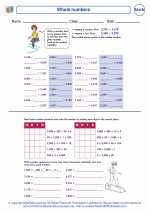Whole Numbers to Trillions
In mathematics, whole numbers are the numbers 0, 1, 2, 3, 4, 5, and so on. Whole numbers do not include any fractions or decimals. When we count, we use whole numbers. In this study guide, we will learn how to work with whole numbers up to trillions.
Place Value
Place value is the value of a digit based on its position in a number. It helps us understand the value of each digit in a number. The place values of digits in whole numbers from ones to trillions are as follows:
- Ones: 1, 2, 3, 4, 5, 6, 7, 8, 9
- Tens: 10, 20, 30, 40, 50, 60, 70, 80, 90
- Hundreds: 100, 200, 300, 400, 500, 600, 700, 800, 900
- Thousands: 1,000, 2,000, 3,000, 4,000, 5,000, 6,000, 7,000, 8,000, 9,000
- Millions: 1,000,000, 2,000,000, 3,000,000, 4,000,000, 5,000,000, 6,000,000, 7,000,000, 8,000,000, 9,000,000
- Billions: 1,000,000,000, 2,000,000,000, 3,000,000,000, 4,000,000,000, 5,000,000,000, 6,000,000,000, 7,000,000,000, 8,000,000,000, 9,000,000,000
- Trillions: 1,000,000,000,000, 2,000,000,000,000, 3,000,000,000,000, 4,000,000,000,000, 5,000,000,000,000, 6,000,000,000,000, 7,000,000,000,000, 8,000,000,000,000, 9,000,000,000,000
Rounding Whole Numbers
Rounding is a way to estimate the value of a number to a certain place value. To round a whole number to the nearest tens, hundreds, thousands, millions, billions, or trillions, follow these steps:
- Determine the place value you want to round to.
- Look at the digit to the right of the place value. If it is 5 or greater, round the number up. If it is less than 5, round the number down.
- Change all the digits to the right of the place value to zeros.
Addition and Subtraction of Whole Numbers
When adding or subtracting whole numbers, it's important to line up the digits based on their place values and carry over or borrow when necessary. Here are the steps to add or subtract whole numbers:
- Line up the numbers by place value.
- Add or subtract each column, starting from the right.
- Carry over or borrow as needed.
Multiplication and Division of Whole Numbers
When multiplying or dividing whole numbers, it's important to keep track of the place values and the number of digits in the final answer. Here are the steps to multiply or divide whole numbers:
- Write the numbers to be multiplied or divided, lined up by place value.
- Multiply or divide each digit in the top number by each digit in the bottom number, starting from the right.
- Add or subtract the results to get the final answer.
With practice, you can become proficient in working with whole numbers up to trillions. It's important to understand place value, rounding, addition, subtraction, multiplication, and division to work with these large numbers effectively.
Remember, practice makes perfect, so be sure to work on plenty of problems to reinforce your understanding of whole numbers up to trillions!
Good luck!
[Whole Numbers To Trillions] Related Worksheets and Study Guides:
.◂Math Worksheets and Study Guides Sixth Grade. Whole Numbers to Trillions
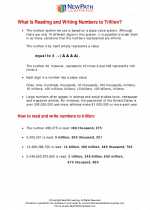
 Worksheet/Answer key
Worksheet/Answer key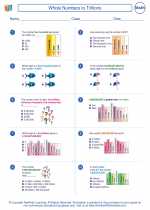
 Worksheet/Answer key
Worksheet/Answer key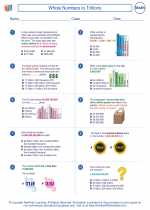
 Worksheet/Answer key
Worksheet/Answer key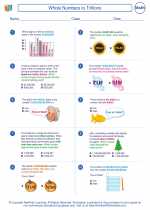
 Worksheet/Answer key
Worksheet/Answer key